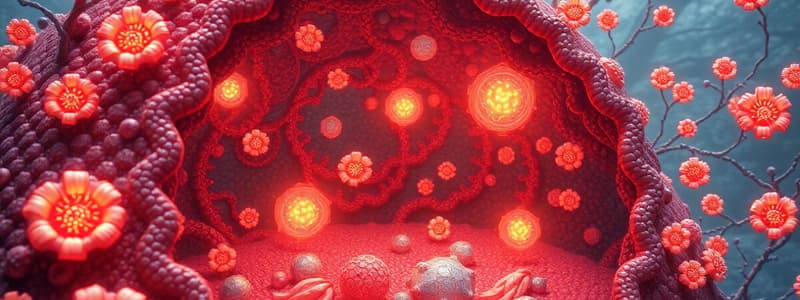Podcast
Questions and Answers
What characterizes active transport in cellular processes?
What characterizes active transport in cellular processes?
- Substances moving without energy input
- Movement of substances along the concentration gradient
- A passive process requiring no protein assistance
- Utilization of ATP to move substances (correct)
Which of the following substances typically requires facilitated diffusion to cross the cell membrane?
Which of the following substances typically requires facilitated diffusion to cross the cell membrane?
- Glucose (correct)
- Carbon Dioxide
- Oxygen
- Alcohol
How do substances move during the process of diffusion?
How do substances move during the process of diffusion?
- From high to low concentration until equilibrium is reached (correct)
- Randomly without any concentration influence
- Only through integral proteins of the membrane
- Against the concentration gradient using energy
What is the primary requirement for a substance to undergo osmosis?
What is the primary requirement for a substance to undergo osmosis?
Which process involves substances moving out of the cell using energy?
Which process involves substances moving out of the cell using energy?
What is the primary purpose of osmosis in biological systems?
What is the primary purpose of osmosis in biological systems?
What occurs when a cell is placed in a hypotonic solution?
What occurs when a cell is placed in a hypotonic solution?
What is osmotic pressure primarily dependent upon?
What is osmotic pressure primarily dependent upon?
Which type of solution has equal concentrations of solutes and water across the membrane?
Which type of solution has equal concentrations of solutes and water across the membrane?
What type of process is filtration mainly driven by?
What type of process is filtration mainly driven by?
What is the function of dialysis in biological systems?
What is the function of dialysis in biological systems?
What happens to a cell placed in a hypertonic solution?
What happens to a cell placed in a hypertonic solution?
In which organ does filtration primarily occur?
In which organ does filtration primarily occur?
Which statement accurately describes osmosis?
Which statement accurately describes osmosis?
What primarily determines the rate of osmosis?
What primarily determines the rate of osmosis?
Flashcards
Diffusion
Diffusion
The movement of molecules from a region of high concentration to a region of low concentration until equilibrium is reached.
Facilitated Diffusion
Facilitated Diffusion
Diffusion facilitated by carrier proteins embedded in the cell membrane. This allows larger molecules, like glucose, to move across the membrane.
Osmosis
Osmosis
The movement of water molecules across a semi-permeable membrane from an area of high water concentration to an area of low water concentration.
Filtration
Filtration
Signup and view all the flashcards
Passive Transport
Passive Transport
Signup and view all the flashcards
Osmotic Pressure
Osmotic Pressure
Signup and view all the flashcards
Isotonic Solution
Isotonic Solution
Signup and view all the flashcards
Hypotonic Solution
Hypotonic Solution
Signup and view all the flashcards
Hypertonic Solution
Hypertonic Solution
Signup and view all the flashcards
Dialysis
Dialysis
Signup and view all the flashcards
Study Notes
Transport Through the Cell Membrane
- Mechanisms for substance movement across the plasma membrane are crucial for cell life
- Substances move in and out of the cell for essential functions
- Substances can move passively or actively
Passive Processes
- Passive processes do not require energy (ATP) from the cell
- Substances move down their concentration gradient (high to low concentration)
- Pressure differences can also drive movement
- Examples:
- Diffusion: Net movement of molecules/ions from high to low concentration until equilibrium
- Facilitated Diffusion: Movement of larger molecules through carrier proteins in the membrane
- Osmosis: Movement of water across a selectively permeable membrane from high to low water concentration
- Filtration: Movement of solvent and small solute molecules driven by hydrostatic pressure
- Dialysis: Separation of small molecules from larger molecules through a selectively permeable membrane
Active Processes
- Active processes require energy (ATP)
- Substances move against their concentration gradient
- Examples:
- Active Transport: Movement of substances from low to high concentration using carrier proteins
- Sodium-Potassium Pump: An example of active transport moving sodium out and potassium into the cell
- Endocytosis: Cell membrane engulfs large particles, e.g., phagocytosis (solid) or pinocytosis (liquid). Membrane folds to form a vesicle that carries the particles into the cell
- Exocytosis: Opposite of endocytosis, substances enclosed in vesicles fuse with the cell membrane to release contents outside the cell
Studying That Suits You
Use AI to generate personalized quizzes and flashcards to suit your learning preferences.



